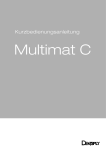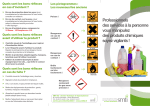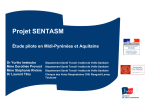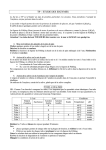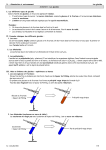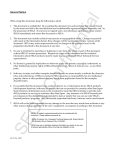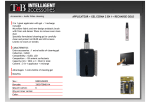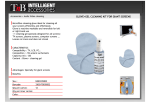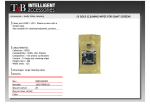Download USER GUIDE GREENFLOC 213A
Transcript
U SER GU ID E Date of issue: 12.06.2005 GREENFLOC® 213A 1. Identification of the substance/preparation and of the company Identification of the product Product name: Greenfloc 213A anionic flocculant Manufacturer/supplier identification HYDRA 2002 Research, Development and Consulting Ltd. Address: Ovaros ter 14. 8200 Veszprem, Hungary Phone/Fax: +36 88 422-104 E-mail: [email protected] 2. Introduction of the product Greenfloc 213A is an environmentally friendly, starch based, anionic flocculant. Because of its non toxic character its application is very advantageous in drinking water treatment, in the food industry or in the biotecnology either alone as flocculant or together with Al- or Fe-salts as coagulant aid. Composition/information on ingredients Starch derivative, starch phosphate CAS-No.: 11120-02-8 − OH -groups of the native starch – (C6H10O5)n – are partly substituted by [PO4]3−-groups (DS≈0,03). Physical and chemical properties Form: Colour: Odour: pH value: Melting point: Boiling point: Ignition temperature: Flash point: Explosion limits lower: upper: Density: Bulk density: Solubility in water: Thermal decomposition: powder pale yellow odourless pH=7 in 100 g/L H2O slurry not available not available ~ 400 oC not available not available not available not available 500-700 kg/m3 insoluble in cold water, after swelling partially soluble in hot water. ~ 200 oC 3. Authorization Approved flocculant for food industry (No.2415/1991/OÉTI) and for drinking water treatment (OTH-2748/2003). 1/2 USER GUIDE GREENFLOC 213A 4. Application Application area Greenfloc 213A can be used in the drinking water treatment, sugar industry, food industry, paper making, other chemical technologies, wastewater treatment alone or together with coagulants as coagulant aid. It can be mixed with synthetic anionic flocculants. Dosage In drinking water treatment with Al-or Fe-salts the usual dosage is 0,1-0,5 g/m3 water maximal approved dosage is 1 g/m3. In food industry and in other technologies the dosage is depending on many parameters, the recommended dosage is ranging between 0,1-50 g/m3. Dissolution of the flocculant • • 1 part of the flocculant is mixed with 9 part of cold water, stirred and heated up to 70 o C, then it is diluted to 0.1 w/w% with cold water. This solution is added to the suspension to be flocculated. 1 part of the flocculant is mixed with 5 part of cold water. 0.25 part of 40% NaOH is added. The mixture is stirred continuously ½ hours and and diluted to 0.1 w/w% with cold water. This solution is added to the suspension to be flocculated. 5. Handling and storage Powder: Tightly closed. Dry. No further requirements. At +5oC-+25oC can be stored for 2 years. Solution: The solution of the product should not be stored for more than a day. In case of longer storage its efficiency decreases, and it can be fermented, biologically degraded. 6. Hazards identification According to the results of the study No.2415/1991/OÉTI (National Institute of Food-Hygiene and Nutrition) the material should be enlisted in the practically non toxic category. 7. First aid measures After inhalation: After skin contact: After eye contact: fresh air. wash off water. rinse out with water. 8. Accidental release measures Person-related precautionary measures: Avoid generation of dusts; do not inhale dusts. Procedures for cleaning/absorption: Clean up affected area. Avoid generation of dusts. Wet floor may be slippery when material is present. 2/2




